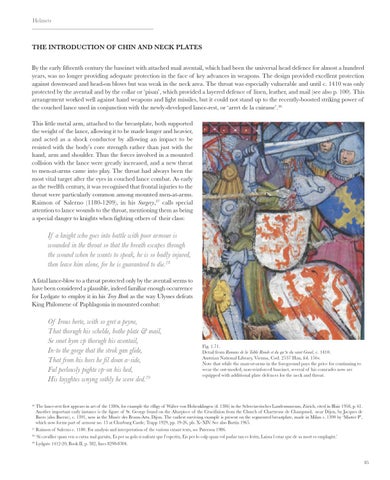Helmets
THE INTRODUCTION OF CHIN AND NECK PLATES By the early fifteenth century the bascinet with attached mail aventail, which had been the universal head defence for almost a hundred years, was no longer providing adequate protection in the face of key advances in weapons. The design provided excellent protection against downward and head-on blows but was weak in the neck area. The throat was especially vulnerable and until c. 1410 was only protected by the aventail and by the collar or ‘pisan’, which provided a layered defence of linen, leather, and mail (see also p. 100). This arrangement worked well against hand weapons and light missiles, but it could not stand up to the recently-boosted striking power of the couched lance used in conjunction with the newly-developed lance-rest, or ‘arret de la cuirasse’.26 This little metal arm, attached to the breastplate, both supported the weight of the lance, allowing it to be made longer and heavier, and acted as a shock conductor by allowing an impact to be resisted with the body’s core strength rather than just with the hand, arm and shoulder. Thus the forces involved in a mounted collision with the lance were greatly increased, and a new threat to men-at-arms came into play. The throat had always been the most vital target after the eyes in couched lance combat. As early as the twelfth century, it was recognised that frontal injuries to the throat were particularly common among mounted men-at-arms. Raimon of Salerno (1180-1209), in his Surgery,27 calls special attention to lance wounds to the throat, mentioning them as being a special danger to knights when fighting others of their class:
If a knight who goes into battle with poor armour is wounded in the throat so that the breath escapes through the wound when he wants to speak, he is so badly injured, then leave him alone, for he is guaranteed to die.28
A fatal lance-blow to a throat protected only by the aventail seems to have been considered a plausible, indeed familiar enough occurrence for Lydgate to employ it in his Troy Book as the way Ulysses defeats King Philomene of Paphlagonia in mounted combat:
Of Irous herte, with so gret a peyne, That thorugh his schelde, bothe plate & mail, Se smet hym vp thorugh his aventail, In-to the gorge that the strok gan glide, That from his hors he fil doun a-side, Ful perlously pighte vp-on his hed, His knyghtes wnyng sothly he were ded.29
26
27 28 29
Fig. 1.71. Detail from Romans de la Table Ronde et du quˆte du saint Graal, c. 1410. Austrian National Library, Vienna, Cod. 2537 Han, fol. 156v. Note that while the man-at-arms in the foreground pays the price for continuing to wear the out-moded, non-reinforced bascinet, several of his comrades now are equipped with additional plate defences for the neck and throat.
The lance-rest first appears in art of the 1380s, for example the effigy of Walter von Hohenklingen (d. 1386) in the Schweizerisches Landesmuseum, Zürich, cited in Blair 1958, p. 61. Another important early instance is the figure of St. George found on the Altarpiece of the Crucifixion from the Church of Chartreuse de Champmol, near Dijon, by Jacques de Baers (also Baerze), c. 1391, now in the Musée des Beaux-Arts, Dijon. The earliest surviving example is present on the segmented breastplate, made in Milan c. 1390 by ‘Master P’, which now forms part of armour no. 13 at Churburg Castle; Trapp 1929, pp. 19-26, pls. X- XIV. See also Buttin 1965. Raimon of Salerno c. 1180. For analysis and interpretation of the various extant texts, see Paterson 1986.
‘Si cavallier quan ven a cutxa mal garnitz, Es per sa gola si nafratz que l’esperitz, Eis per lo colp quan vol parlar tan es feritz, Laissa l estar que de sa mort es emplagitz.’ Lydgate 1412-20, Book II, p. 382, lines 8298-8304.
85
